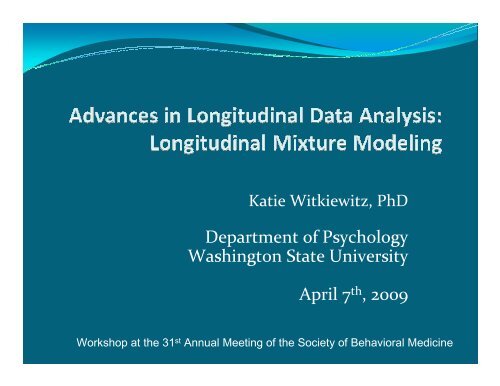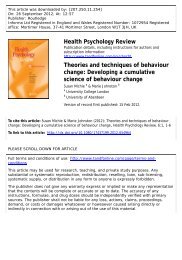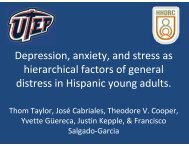Advances in Longitudinal Data Analysis - Society of Behavioral ...
Advances in Longitudinal Data Analysis - Society of Behavioral ...
Advances in Longitudinal Data Analysis - Society of Behavioral ...
- No tags were found...
You also want an ePaper? Increase the reach of your titles
YUMPU automatically turns print PDFs into web optimized ePapers that Google loves.
Katie Witkiewitz, PhDDepartment <strong>of</strong> PsychologyWash<strong>in</strong>gton State UniversityApril 7 th , 2009Workshop at the 31 st Annual Meet<strong>in</strong>g <strong>of</strong> the <strong>Society</strong> <strong>of</strong> <strong>Behavioral</strong> Medic<strong>in</strong>e
Goal <strong>of</strong> sem<strong>in</strong>ar is to <strong>in</strong>troduce basicconcepts, term<strong>in</strong>ology and potentialapplications <strong>of</strong> longitud<strong>in</strong>al mixture models2
What will not be covered?Level 1: y it = η 0i + η 1i x t + ε it ,Level 2: η 0i = α 0 + ζ 0iη 1i = α 1 + ζ 1iOr…3
Why learn about longitud<strong>in</strong>al mixturemodel<strong>in</strong>g?Depends on your research question…5
Question 1: How do<strong>in</strong>dividuals change theirdr<strong>in</strong>k<strong>in</strong>g behavior follow<strong>in</strong>gtreatment?6
Individual dr<strong>in</strong>k<strong>in</strong>g patterns (n(= 395)follow<strong>in</strong>g an <strong>in</strong>itial post-treatmenttreatmentlapse7
Question 2: Does the number<strong>of</strong> cigarettes smoked per daychange dur<strong>in</strong>g telephonetobacco counsel<strong>in</strong>g?8
Cigarettes per day dur<strong>in</strong>g telephone smok<strong>in</strong>gcessation calls (n = 11,927)9
Question 3: Are therechanges <strong>in</strong> quit status aftertelephone tobaccocounsel<strong>in</strong>g?10
Quit status 6- and 12-months follow<strong>in</strong>g telephonetobacco counsel<strong>in</strong>g (n = 7,624)11
Question 4: How do weexam<strong>in</strong>e the effects <strong>of</strong>weight loss <strong>in</strong>terventionwhen some <strong>in</strong>dividuals <strong>in</strong> thetreatment group are nonresponders?12
Response to weight-loss <strong>in</strong>terventionWeight loss <strong>in</strong>terventionHealthy eat<strong>in</strong>g behaviorControlInterventionTimeThe non-responders <strong>in</strong> the <strong>in</strong>tervention group lessen the effect size <strong>of</strong> the<strong>in</strong>tervention <strong>in</strong> comparison to the control group13
Examples <strong>of</strong> Longitud<strong>in</strong>al Mixture Model<strong>in</strong>gBooth, K. M. (2003). Evaluat<strong>in</strong>g academic outcomes <strong>of</strong> head start: An application <strong>of</strong> general growth mixture model<strong>in</strong>g. EarlyChildhood Research Quarterly, 18(2), 238-254.Colder, C. R., Campbell, R. T., Ruel, E., Richardson, J. L., Flay, B. R. (2002). A f<strong>in</strong>ite mixture model <strong>of</strong> growth trajectories <strong>of</strong>adolescent alcohol use: Predictors and consequences. Journal <strong>of</strong> Consult<strong>in</strong>g & Cl<strong>in</strong>ical Psychology, 70(4), 976-985.Ellickson, P. L., Mart<strong>in</strong>o, S. C., Coll<strong>in</strong>s, R. L. (2004). Marijuana use from adolescence to young adulthood: Multipledevelopmental trajectories and their associated outcomes. Health Psychology, 23(3), 299-307.Muthén, B., et al., (2002). General growth mixture model<strong>in</strong>g for randomized preventive <strong>in</strong>terventions. Biostatistics, 3, 459-475.Muthén, B. & Muthén, L. (2000). Integrat<strong>in</strong>g person-centered and variable-centered analyses: Growth mixture model<strong>in</strong>g withlatent trajectory classes. Alcoholism: Cl<strong>in</strong>ical and Experimental Research, 24, 882-891.Nag<strong>in</strong>, D.S., & Tremblay, R.E. (1999). Trajectories <strong>of</strong> boys' physical aggression, opposition, and hyperactivity on the path tophysically violent and non-violent juvenile del<strong>in</strong>quency. Child Development, 70, 1181-1196.Orlando, M., Tucker, J. S., Ellickson, P. L., Kle<strong>in</strong>, D. J. (2004). Developmental trajectories <strong>of</strong> cigarette smok<strong>in</strong>g and theircorrelates from early adolescence to young adulthood. Journal <strong>of</strong> Consult<strong>in</strong>g & Cl<strong>in</strong>ical Psychology, 72(3), 400-410.Orcutt, H. K., Erickson, D. J., Wolfe, J. (2004). The course <strong>of</strong> PTSD symptoms among Gulf War Veterans: A growth mixturemodel<strong>in</strong>g approach. Journal <strong>of</strong> Traumatic Stress, 17(3), 195-202.Schaeffer, C. M; Petras, H., Ialongo, N., Poduska, J., Kellam, S. (2003). Model<strong>in</strong>g growth <strong>in</strong> boys' aggressive behavior acrosselementary school: L<strong>in</strong>ks to later crim<strong>in</strong>al <strong>in</strong>volvement, conduct disorder, and antisocial personality disorder. DevelopmentalPsychology, 39(6), 1020-1035.Wiesner, M., Silbereisen, R. K. (2003). Trajectories <strong>of</strong> del<strong>in</strong>quent behaviour <strong>in</strong> adolescence and their covariates: Relations with<strong>in</strong>itial and time-averaged factors. Journal <strong>of</strong> Adolescence, 26(6), 753-771.Witkiewitz, K. & Masyn, K.M. (2008)Dr<strong>in</strong>k<strong>in</strong>g trajectories follow<strong>in</strong>g an <strong>in</strong>itial lapse. Psychology <strong>of</strong> Addictive Behaviors, 22, 157-167.Witkiewitz, K., van der Maas, H. J., Hufford, M. R., & Marlatt, G. A. (2007). Non-Normality and Divergence <strong>in</strong> Post-TreatmentAlcohol Use: Re-Exam<strong>in</strong><strong>in</strong>g the Project MATCH <strong>Data</strong> “Another Way.” Journal <strong>of</strong> Abnormal Psychology, 116, 378-394.Witkiewitz, K., & Villarroel, N. (2009). Dynamic association between negative affect and alcohol lapses follow<strong>in</strong>g alcoholtreatment. Journal <strong>of</strong> Consult<strong>in</strong>g and Cl<strong>in</strong>ical Psychology, 77, 633-644.14
Latent Variableunobserved; unmeasured; based onrelationships between observed variablesobservedvariable (x1)observedvariable (x2)observedvariable (x3)observed; measuredvariablesE1E2E3error or “residual,” notexpla<strong>in</strong>ed by sharedvariance16
YYLatent variables can be cont<strong>in</strong>uous or categorical; tworepresentations <strong>of</strong> the same realityXXCont<strong>in</strong>uous latent variable – correlationexpla<strong>in</strong>ed by underly<strong>in</strong>g factorEx. structural equation models, factormodels, growth curve models, multilevelmodelsCategorical latent variable – correlationreflects difference between discretegroups on mean levels <strong>of</strong> observedvariablesEx. latent class analysis, mixtureanalyses, latent transition analysis,latent pr<strong>of</strong>ile analysis17
Types <strong>of</strong> modelsCategorical &Categorical latent variable cont<strong>in</strong>uous latentvariableCross-sectional Latent class analysis Factor mixture analysisLatent pr<strong>of</strong>ile analysisLongitud<strong>in</strong>al Latent transition analysis Growth mixture model<strong>in</strong>gLatent Markov modelLatent class growth analysis18
F<strong>in</strong>ite Mixture Model<strong>in</strong>g19
Direct and Indirect Applications1.Direct: identify dist<strong>in</strong>ct subpopulations <strong>of</strong> <strong>in</strong>dividualsObta<strong>in</strong> estimates <strong>of</strong> the conditional distributionsCalculate posterior probabilities that <strong>in</strong>dividual n camefrom subpopulation k2. Indirect: approximate <strong>in</strong>tractable distribution with asmall number <strong>of</strong> simpler component distributions20
latent pr<strong>of</strong>ile analysislatent class analysis
Latent pr<strong>of</strong>ile analysis = categorical latent variableobserved cont<strong>in</strong>uous variables“Pr<strong>of</strong>iles”% heavydr<strong>in</strong>k<strong>in</strong>g daysEWitkiewitz et al. (2007). J. <strong>of</strong> Abnormal Psych. 22
Latent pr<strong>of</strong>ile analysis = categorical latent variableobserved cont<strong>in</strong>uous variablesClass 1= <strong>in</strong>frequent dr<strong>in</strong>k<strong>in</strong>g (78%)Class 2 = occasional dr<strong>in</strong>k<strong>in</strong>g (12%)Class 3 = frequent dr<strong>in</strong>k<strong>in</strong>g (10%)“Pr<strong>of</strong>iles”% heavydr<strong>in</strong>k<strong>in</strong>gdaysE23
Latent class analysis = categorical latent variableobserved categorical variablesResponses Joe Jane Bob BettyAny smok<strong>in</strong>g Yes Yes No NoAny smok<strong>in</strong>g“CLASS”Cigarettes perdayStage <strong>of</strong>changeE E ECigarettes perday = 0No No Yes YesCigarettes perday
Latent class analysis = categorical latent variableobserved categorical variablesClass 1= non smok<strong>in</strong>g, action stage (10%)Class 2 = smok<strong>in</strong>g, 12-20 CPD, preparation stage (13%)Class 3 = smok<strong>in</strong>g, 20+ CPD, preparation stage (77%)Any smok<strong>in</strong>g“CLASS”Cigarettes perdayStage <strong>of</strong>changeE E EProbability <strong>of</strong>endors<strong>in</strong>gC1 C2 C3Any smok<strong>in</strong>g 0.00 1.00 1.000 CPD 1.00 0.00 0.0012-20 CPD 0.00 1.00 0.3420+ CPD 0.00 0.00 0.38Contemplation 0.00 0.00 0.07Preparation 0.11 0.99 0.93Action 0.89 0.01 0.0025
Latent Growth Mixture ModelLatent Markov ModelLatent Transition <strong>Analysis</strong>Repeated Measures Latent Class <strong>Analysis</strong>
yLatent Growth Curve = longitud<strong>in</strong>al cont<strong>in</strong>uous latent variableBillJaneJoey it = η 0i + η 1ix t + ε itGordanSueInterceptη oSlopeη 11 2 3timeTime 1 Time 2 Time 3X 1 X 2X 3ε 1 ε 2 ε 327
Latent growth model28
Latent Growth Mixture Model: Comb<strong>in</strong>ed cont<strong>in</strong>uousand categorical latent variable modelCLASS(“mixture”)• Growth factors (ie. random effects) are<strong>in</strong>dicators <strong>of</strong> latent trajectory “classes”InterceptSlopePost-treatmentWeek 10Week26Week52ε 1 ε 2 ε 3 ε 429
Latent Growth Mixture Model30
Latent Class Growth <strong>Analysis</strong> (i.e., semi-parametricgroup-based model<strong>in</strong>g): Comb<strong>in</strong>ed cont<strong>in</strong>uous andcategorical latent variable modelCLASS(“mixture”)InterceptSlopeAll variances <strong>in</strong> trajectories expla<strong>in</strong>ed byclassification! With no variation aroundtrajectories…Post-treatmentWeek 10Week26Week52ε 1 ε 2 ε 3 ε 431
Latent Class Growth <strong>Analysis</strong>32
Latent Markov model = estimate probability <strong>of</strong>transition<strong>in</strong>g over timeex. Percent heavy dr<strong>in</strong>k<strong>in</strong>g days (%HD)%HDPost-treatment%HD10 weekspost%HD26 weekspost%HD52 weekspost%HD post-treatment%HD 10weeks post%HD 26weeks post%HD 52weeks postEEEE33
Class 1= <strong>in</strong>frequent dr<strong>in</strong>k<strong>in</strong>g (78%)Class 2 = occasional dr<strong>in</strong>k<strong>in</strong>g (12%)Class 3 = frequent dr<strong>in</strong>k<strong>in</strong>g (10%)“Pr<strong>of</strong>iles”% heavydr<strong>in</strong>k<strong>in</strong>gdaysE34
Latent Markov model = estimate probability <strong>of</strong>transition<strong>in</strong>g over timeex. Percent heavy dr<strong>in</strong>k<strong>in</strong>g days (%HD)%HDPost-treatment%HD10 weekspost%HD26 weekspost%HD52 weekspost%HD post-treatment%HD 10weeks post%HD 26weeks post%HD 52weeks postEEEE35
Latent Markov ModelWeek 10 Week 26 Week 52Infreq Occas. Freq. Infreq. Occas. Freq.Week 0 Week 10 Week 26Infreq.n≈1006Occas.n≈162Freq.n≈1280.84 0.13 0.030.18 0.58 0.240.08 0.13 0.79Infreq.n≈887Occas.n≈238Freq.n≈1710.85 0.11 0.040.17 0.59 0.240.11 0.13 0.76Infreq.n≈822Occas.n≈256Freq.n≈218Infreq.n≈831Occas.n≈239Freq.n≈2260.90 0.09 0.010.16 0.54 0.300.08 0.15 0.7736
Latent transition analysis = estimate probability <strong>of</strong>transition<strong>in</strong>g from one class to another over timeSmok<strong>in</strong>gClassCall 1Smok<strong>in</strong>gClassCall 2Any smok<strong>in</strong>gcall 1Cigarettesper day call 1Stage <strong>of</strong>change call 1Any smok<strong>in</strong>gcall 2Cigarettesper day call 2Stage <strong>of</strong>change call 2E E EE E E37
Class 1= non smok<strong>in</strong>g, action stage (10%)Class 2 = smok<strong>in</strong>g, 12-20 CPD, preparation stage (13%)Class 3 = smok<strong>in</strong>g, 20+ CPD, preparation stage (77%)Any smok<strong>in</strong>g“CLASS”Cigarettes perdayStage <strong>of</strong>changeE E EProbability <strong>of</strong>endors<strong>in</strong>gC1 C2 C3Any smok<strong>in</strong>g 0.00 1.00 1.000 CPD 1.00 0.00 0.0012-20 CPD 0.00 1.00 0.3420+ CPD 0.00 0.00 0.38Contemplation 0.00 0.00 0.07Preparation 0.11 0.99 0.93Action 0.89 0.01 0.0038
Latent transition analysisProbability <strong>of</strong>endors<strong>in</strong>gC1 C2 C3Any smok<strong>in</strong>g 0.00 1.00 1.000 CPD 1.00 0.00 0.0012-20 CPD 0.00 1.00 0.3420+ CPD 0.00 0.00 0.38Contemplation 0.00 0.00 0.07Preparation 0.11 0.99 0.93Action 0.89 0.01 0.00Call 1C1(33%)Call 2C2(10%)C3(57%)C1 (10%) 0.43 0.00 0.57C2 (13%) 0.39 0.51 0.11C3 (77%) 0.00 0.13 0.8739
Repeated measures latent class analysis = estimate %<strong>of</strong> <strong>in</strong>dividuals who follow similar pattern over timeLatent classAny smok<strong>in</strong>gcall 1EAny smok<strong>in</strong>gcall 2EAny smok<strong>in</strong>gcall 3EAnysmok<strong>in</strong>gcall 4EAnysmok<strong>in</strong>gcall 5E40
Repeated measures latent classanalysis41
Prior to runn<strong>in</strong>g any analyses…Is your data appropriate? Check your distributions Sample size and power Time po<strong>in</strong>ts and time scale43
Check your distributionsWitkiewitz et al. (2007). J. <strong>of</strong> Abnormal Psych.44
Sample size and power Most LMMs are estimated with large samples No set guidel<strong>in</strong>es for parameter-to-n ratio Monte Carlo study to determ<strong>in</strong>e sample size for givenmodel (Muthen & Muthen, (2002) Structural Equation Model<strong>in</strong>g )45
Time, it’s on your side… # <strong>of</strong> time po<strong>in</strong>ts? Growth mixture models - 3 is enough, but not ideal Latent Markov/transition analysis - 2 is enough Time scale? Age Calendar time Cl<strong>in</strong>ically mean<strong>in</strong>gful scal<strong>in</strong>g46
Model selection & estimation Class enumeration and model fit evaluation Type <strong>of</strong> mixture model? Parameter restrictions Start<strong>in</strong>g values47
Class Enumeration???48
Fit Indices Information Criteria – based on loglikelihood and # <strong>of</strong>parameters Akaike’s Information Criteria (AIC) Bayes Information Criteria (BIC) Adjusted BIC Lo-Mendell-Rub<strong>in</strong> likelihood ratio test (LMR) andbootstrapped likelihood ratio test (BLRT) k-1 vs. k class model49
Classification precision Model entropy criteria – range from 0 to 1 Average Latent Class Probabilities for Most LikelyLatent Class Membership by Latent ClassExample.Latent class assignment1 2 3Most likely latent class 1 0.875 0.106 0.0192 0.060 0.913 0.0283 0.021 0.051 0.92850
Assess<strong>in</strong>g Model Fit <strong>in</strong> PracticeExample : Dr<strong>in</strong>k<strong>in</strong>g trajectories follow<strong>in</strong>g an <strong>in</strong>itial lapse Type: Growth mixture model Class enumeration: 1-5 classes estimated Sample-size adjusted BIC (aBIC) prefer lower values Bootstrapped likelihood ratio test (k vs. k-1)51
Example 1: Observed data…(n = 395; % days abst<strong>in</strong>ent per month, dur<strong>in</strong>g themonths follow<strong>in</strong>g an <strong>in</strong>itial post-treatment lapse)52
Two Class Growth Mixture Model % Days Abst<strong>in</strong>entEntropy = .95aBIC = 30510.36How does itcompare to a oneclass Model?aBIC = 30707.75BLRT = 200.24 (p
Three Class Growth Mixture Model: % Days Abst<strong>in</strong>entEntropy = .91aBIC = 30458.312-Class ModelaBIC = 30510.36BLRT = 70.23 (p = .20)54
Four Class Growth Mixture Model: % Days Abst<strong>in</strong>entEntropy = .92aBIC = 30316.963-Class ModelaBIC = 30458.31BLRT = 147.64 (p < .0005)BLRT <strong>of</strong> 5 class model = 25.76 (p = .85)55
Type <strong>of</strong> mixture model???56
Example 2: Observed data…(n = 1,383; % heavy dr<strong>in</strong>k<strong>in</strong>g days post-treatment)57
Comparison <strong>of</strong> latent growth mixture andMarkov models Growth mixture: 3-class model based on LMR Entropy = 0.98 BIC (3-class GMM) = 43886.02 Markov model: 3-class model based on LMR Entropy = 0.95 BIC (3-class LMM) = 41045.22Witkiewitz, Maisto, & Donovan (under review)58
Latent Growth Mixture Model59
Growth mixture model:“Infrequent heavy dr<strong>in</strong>k<strong>in</strong>g class”60
Growth mixture model:“Occasional heavy dr<strong>in</strong>k<strong>in</strong>g class”61
Growth mixture model:“Frequent heavy dr<strong>in</strong>k<strong>in</strong>g class”62
Latent Markov model:“Infrequent heavy dr<strong>in</strong>k<strong>in</strong>g class pattern”63
Latent Markov model:“Infrequent to occasional heavy dr<strong>in</strong>k<strong>in</strong>gclass pattern”64
Latent Markov model:“Frequent heavy dr<strong>in</strong>k<strong>in</strong>g class pattern”65
Cross-classification <strong>of</strong> models66
A few more sticky issues Parameter restrictions Equality constra<strong>in</strong>ts Sett<strong>in</strong>g parameters to specific values (0, 1, known value) Start<strong>in</strong>g values Local solutions - erratic likelihood functions Substantively different results Multiple random start<strong>in</strong>g values can help exam<strong>in</strong>elikelihood space (Hipp & Bauer, 2006)67
Common research questionsDo different levels <strong>of</strong> x correspond to agreater likelihood <strong>of</strong> be<strong>in</strong>g <strong>in</strong> class y?MotivationMotivationWhat is the relationship between x andwith<strong>in</strong> class change over time?CLASSInterceptDoes class membershippredict outcome y?Slope3 year dr<strong>in</strong>k<strong>in</strong>gTime 1Time 2ε 1ε 2ε 3ε 4Time 3Time 469
Growth Mixture Model with CovariatesCop<strong>in</strong>gCognitionAffectDistal RiskIntercept"Class"Simplified Growth Mixture ModelPDA = % days abst<strong>in</strong>entMo = follow-up monthSlopeMo.1PDAE12Mo.2PDAMo.3PDAMo. 4PDAMo. 5PDAMo. 6PDAMo. 7PDAMo. 8PDAMo. 9PDAMo.10PDAE3Mo.11PDAE2Mo.12PDA1 1 1 1 11 1 1 1 111E11E10E9E8E7E6E5E4E170
Growth Mixture Model with Covariatespredict<strong>in</strong>g class membershipDr<strong>in</strong>k<strong>in</strong>g Class Cop<strong>in</strong>g AffectDistalriskCognitiveriskInfrequent 1.84* -.03 -.05* .06*Occasional 1.45* .005 -.01 .02Prolapsers 1.24* .06 -.08* .05*Frequent ** ** ** **Frequent dr<strong>in</strong>kers vs. other classes significantly lower cop<strong>in</strong>g scores vs. all classes* = (p
Growth Mixture Model with covariatespredict<strong>in</strong>g with<strong>in</strong> class growthcovariateCLASSInterceptSlopeTime1Time2Time3Time4ε 1ε 2ε 3ε 472
Covariates predict<strong>in</strong>g with<strong>in</strong> class growthWitkiewitz & Masyn (2008). Psych Addictive Behaviors73
“Predict<strong>in</strong>g” a distal outcomeDoes class membershippredict outcome y?Latent class12-month po<strong>in</strong>tprevalenceAny smok<strong>in</strong>gcall 1EAny smok<strong>in</strong>gcall 2EAny smok<strong>in</strong>gcall 3EAnysmok<strong>in</strong>gcall 4EAnysmok<strong>in</strong>gcall 5E74
Predict 12-month po<strong>in</strong>t prevalenceEquality tests <strong>of</strong> mean 12-month po<strong>in</strong>t prevalence acrossclasses us<strong>in</strong>g posterior probability-based multiple imputationsClass 1 (mean = .23) vs. Class 2 (mean = .46)Class 1 vs. Class 3 (mean = .52)χ2 , p-value72.54, p
Latent transition analysis with time<strong>in</strong>variantcovariate predict<strong>in</strong>g classes andtransitions between classesPDAPost-TxDDDPost-TxDrInCPost-TxPDAMo.6DDDMo.6DrIncMo.6PDAMo.12DDDMo.12DrIncMo.12C1C2C3Alcoholdependence76
Latent transition analysis with time<strong>in</strong>variantcovariate predict<strong>in</strong>g classes andtransitions between classesWitkiewitz (2008). J Stud Alcohol Drugs.77
Limitations: Longitud<strong>in</strong>al Mixture Models User specified number <strong>of</strong> latent classes Classes are not real and true # <strong>of</strong> classes never known All sorts <strong>of</strong> model<strong>in</strong>g issues See Bauer (2007). Multivariate Behav ResearchBauer & Curran (2003/2004). Psych MethodsHipp & Bauer (2006). Psych MethodsSampson & Laub (2005). Crim<strong>in</strong>ology Add<strong>in</strong>g covariates Non-normality and nonl<strong>in</strong>earity can result <strong>in</strong> spuriousclass-by-predictor relationships Can change underly<strong>in</strong>g latent classes79
Summary <strong>of</strong> model<strong>in</strong>g issues Over-extraction <strong>of</strong> latent classes (Bauer & Curran, 2003) Reification <strong>of</strong> groups that do not exist (Raudenbush, 2005) Loss <strong>of</strong> power - artificially divid<strong>in</strong>g growth trajectories <strong>in</strong>toclasses Spurious covariate by class <strong>in</strong>teractions that do not exist(Bauer & Curran, 2003)80
Bauer and Curran (2003):“All <strong>of</strong> our models are wrong, and it is quite possiblethat there is no “right” model to discern whatsoever.The real task at hand is to decide which model is mostuseful” (p. 388).81
S<strong>of</strong>tware Mplus – www.statmodel.com Mx - http://www.vcu.edu/mx/ SAS ProcTraj - http://www.andrew.cmu.edu/user/bjones/ SAS ProcLCA/ProcLTA -http://methodology.psu.edu/<strong>in</strong>dex.php/downloads/proclcalta Latent Gold - http://www.statistical<strong>in</strong>novations.com/ Open Mx - http://openmx.psyc.virg<strong>in</strong>ia.edu/ Others?83
Screen shot <strong>of</strong> mplus webpage84
Screen shot <strong>of</strong> LGMMcommands85
WARNING: WHEN ESTIMATING A MODEL WITH MORE THAN TWO CLASSES,IT MAY BE NECESSARY TO INCREASE THE NUMBER OF RANDOM STARTSUSING THE STARTS OPTION TO AVOID LOCAL MAXIMA.THE MODEL ESTIMATION TERMINATED NORMALLYTESTS OF MODEL FITLoglikelihoodH0 Value -21907.093H0 Scal<strong>in</strong>g Correction Factor 1.949for MLRInformation CriteriaNumber <strong>of</strong> Free Parameters 18Akaike (AIC) 43850.186Bayesian (BIC) 43943.193Sample-Size Adjusted BIC 43886.015(n* = (n + 2) / 24)86
FINAL CLASS COUNTS AND PROPORTIONS FOR THE LATENTCLASSES BASED ON THE ESTIMATED MODELLatent Classes1 158.22360 0.122092 1009.38814 0.778853 128.38827 0.09907FINAL CLASS COUNTS AND PROPORTIONS FOR THE LATENTCLASS PATTERNS BASED ON ESTIMATED POSTERIORPROBABILITIESLatent Classes1 158.22360 0.122092 1009.38813 0.778853 128.38827 0.09907CLASSIFICATION QUALITYEntropy 0.97987
CLASSIFICATION OF INDIVIDUALS BASED ON THEIR MOSTLIKELY LATENT CLASS MEMBERSHIPClass Counts and ProportionsLatent Classes1 156 0.120372 1011 0.780093 129 0.09954Average Latent Class Probabilities for Most LikelyLatent Class Membership (Row)by Latent Class (Column)1 2 31 0.970 0.027 0.0022 0.006 0.994 0.0003 0.008 0.000 0.99288
MODEL RESULTSTwo-TailedEstimate S.E. Est./S.E. P-ValueLatent Class 1I |T4_PHD 1.000 0.000 999.000 999.000T26_PHD 1.000 0.000 999.000 999.000T52_PHD 1.000 0.000 999.000 999.000T68_PHD 1.000 0.000 999.000 999.000S |T4_PHD -1.000 0.000 999.000 999.000T26_PHD 0.000 0.000 999.000 999.000T52_PHD 2.600 0.000 999.000 999.000T68_PHD 4.200 0.000 999.000 999.000Q |T4_PHD 1.000 0.000 999.000 999.000T26_PHD 0.000 0.000 999.000 999.000T52_PHD 6.760 0.000 999.000 999.000T68_PHD 17.640 0.000 999.000 999.00089
Two-TailedEstimate S.E. Est./S.E. P-ValueLatent Class 1S WITHI 32.714 2.262 14.460 0.000MeansI 46.136 2.268 20.339 0.000S 3.534 1.426 2.479 0.013Q -0.718 0.310 -2.320 0.020InterceptsT4_PHD 0.000 0.000 999.000 999.000T26_PHD 0.000 0.000 999.000 999.000T52_PHD 0.000 0.000 999.000 999.000T68_PHD 0.000 0.000 999.000 999.000VariancesI 86.389 6.205 13.923 0.000S 26.446 1.933 13.680 0.000Q 0.000 0.000 999.000 999.000Residual VariancesT4_PHD 10.086 4.484 2.249 0.024T26_PHD 342.876 25.345 13.528 0.000T52_PHD 310.972 21.594 14.401 0.000T68_PHD 123.691 27.015 4.579 0.000 90
Estimate S.E. Est./S.E. P-ValueLatent Class 2I |T4_PHD 1.000 0.000 999.000 999.000T26_PHD 1.000 0.000 999.000 999.000T52_PHD 1.000 0.000 999.000 999.000T68_PHD 1.000 0.000 999.000 999.000S |T4_PHD -1.000 0.000 999.000 999.000T26_PHD 0.000 0.000 999.000 999.000T52_PHD 2.600 0.000 999.000 999.000T68_PHD 4.200 0.000 999.000 999.000Q |T4_PHD 1.000 0.000 999.000 999.000T26_PHD 0.000 0.000 999.000 999.000T52_PHD 6.760 0.000 999.000 999.000T68_PHD 17.640 0.000 999.000 999.000S WITHI 32.714 2.262 14.460 0.000MeansI 9.608 0.554 17.328 0.000S 5.368 0.310 17.313 0.000Q -0.825 0.078 -10.584 0.000 91
TECHNICAL 11 OUTPUTRandom Starts Specifications for the k-1 Class <strong>Analysis</strong> ModelNumber <strong>of</strong> <strong>in</strong>itial stage random starts 1000Number <strong>of</strong> f<strong>in</strong>al stage optimizations 200VUONG-LO-MENDELL-RUBIN LIKELIHOOD RATIO TEST FOR 2 (H0) VERSUS 3CLASSESH0 Loglikelihood Value -22251.8162 Times the Loglikelihood Difference 689.446Difference <strong>in</strong> the Number <strong>of</strong> Parameters 4Mean 3.678Standard Deviation 162.623P-Value 0.0005LO-MENDELL-RUBIN ADJUSTED LRT TESTValue 666.207P-Value 0.000692
Screen shot <strong>of</strong> LMM commands93
Latent Markov model cont<strong>in</strong>ued94
LATENT TRANSITION PROBABILITIES BASED ON THE ESTIMATED MODELC16 Classes (Rows) by C26 Classes (Columns)1 2 31 0.578 0.242 0.1802 0.135 0.788 0.0773 0.131 0.029 0.840C26 Classes (Rows) by C52 Classes (Columns)1 2 31 0.587 0.238 0.1742 0.128 0.764 0.1083 0.113 0.036 0.851C52 Classes (Rows) by C68 Classes (Columns)1 2 31 0.537 0.162 0.3012 0.154 0.765 0.0813 0.086 0.017 0.89795
Screen shot <strong>of</strong> LTA commands96
Latent transition analysiscont<strong>in</strong>ued97
Latent transition analysiscont<strong>in</strong>ued98
Screen shot <strong>of</strong> RMLCAcommands99
Repeated measures latentclass analysis cont<strong>in</strong>ued100
Covariates <strong>in</strong> MplusDo different levels <strong>of</strong> x correspond to agreater likelihood <strong>of</strong> be<strong>in</strong>g <strong>in</strong> class y?What is the relationship between x andchange over time across classes?What is the relationship between x andchange over time with<strong>in</strong> classes?Does class membership predict outcome?C#1 C#2 on motiv;icept slope on tx;%C#1%icept slope on tx;%C#2%icept slope on tx;%C#1%[dr<strong>in</strong>k_3]*;%C#2%[dr<strong>in</strong>k_3]*;ORAUXILIARY = dr<strong>in</strong>k_3(e)101
Common Mplus error messagesErrorWARNING: WHEN ESTIMATING A MODEL WITH MORE THAN TWO CLASSES,IT MAY BE NECESSARY TO INCREASE THE NUMBER OF RANDOM STARTSUSING THE STARTS OPTION TO AVOID LOCAL MAXIMA.SolutionMake sure you are us<strong>in</strong>g STARTS =*Note, you will still get this warn<strong>in</strong>g with STARTS commandErrorWARNING: THE BEST LOGLIKELIHOOD VALUE WAS NOT REPLICATED. THESOLUTION MAY NOT BE TRUSTWORTHY DUE TO LOCAL MAXIMA.INCREASE THE NUMBER OF RANDOM STARTS.SolutionIncrease the number <strong>of</strong> random starts.102
Common Mplus error messagesErrorWARNING: THE LATENT VARIABLE COVARIANCE MATRIX (PSI) IN CLASS 1 ISNOT POSITIVE DEFINITE. THIS COULD INDICATE A NEGATIVE VARIANCE/RESIDUAL VARIANCE FOR A LATENT VARIABLE, A CORRELATION GREATEROR EQUAL TO ONE BETWEEN TWO LATENT VARIABLES, OR A LINEARDEPENDENCY AMONG MORE THAN TWO LATENT VARIABLES. CHECK THETECH4 OUTPUT FOR MORE INFORMATION. PROBLEM INVOLVINGVARIABLE S.SolutionCheck the residual variances under Model ResultsVariancesEstimate S.E. Est./S.E. P-ValueI 7.326 3.033 2.416 0.016S -0.709 0.510 -1.392 0.164103
Common Mplus error messagesError(s)THE STANDARD ERRORS OF THE MODEL PARAMETER ESTIMATES MAY NOT BETRUSTWORTHY FOR SOME PARAMETERS DUE TO A NON-POSITIVE DEFINITEFIRST-ORDER DERIVATIVE PRODUCT MATRIX. THIS MAY BE DUE TO THESTARTING VALUES BUT MAY ALSO BE AN INDICATION OF MODELNONIDENTIFICATION. THE CONDITION NUMBER IS 0.186D-16. PROBLEMINVOLVING PARAMETER 18.ONE OR MORE MULTINOMIAL LOGIT PARAMETERS WERE FIXED TO AVOIDSINGULARITY OF THE INFORMATION MATRIX. THE SINGULARITY IS MOSTLIKELY BECAUSE THE MODEL IS NOT IDENTIFIED, OR BECAUSE OF EMPTY CELLSIN THE JOINT DISTRIBUTION OF THE CATEGORICAL LATENT VARIABLES ANDANY INDEPENDENT VARIABLES. THE FOLLOWING PARAMETERS WERE FIXED: 23Potential Solutions-Look at TECH1 output to determ<strong>in</strong>e what parameter is caus<strong>in</strong>g the problem-Increase number <strong>of</strong> random starts-Reduce complexity <strong>of</strong> model via parameter constra<strong>in</strong>ts104
Advanced longitud<strong>in</strong>al mixture models Discrete time survival mixture analysis Multilevel mixture model<strong>in</strong>g Associative latent transition analysis Markov switch<strong>in</strong>g models Alternative model specifications Two-part Piecewise Zero-<strong>in</strong>flated Poisson106
BASIC SETUP Programs can be simple (tak<strong>in</strong>g advantage <strong>of</strong> defaultsett<strong>in</strong>gs) or complex (by mak<strong>in</strong>g specific modelstatements) .dat data files .<strong>in</strong>p <strong>in</strong>put files .out output files .gph graphic files107
COMMAND LINESTITLE:DATA:VARIABLE:DEFINE:ANALYSIS:MODEL:PLOT:OUTPUT:SAVEDATA:• All l<strong>in</strong>es end with ;• Only 80 characters per l<strong>in</strong>e“-” can shorten variable lists (y1-y6)!comments can be used anywhere;108
EXAMPLE PROGRAMTITLE: Dr<strong>in</strong>k<strong>in</strong>g example 1: 2 classes - only l<strong>in</strong>ear slope - No covariatesDATA: FILE IS lgmm.example.dat;VARIABLE:NAMES ARE pda_gm1 pda_gm2 pda_gm3 pda_gm4 pda_gm5;USEVAR ARE pda_gm1-pda_gm5;CLASSES = c(2);ANALYSIS: TYPE = MIXTURE;STARTS = 500 250;MODEL:%OVERALL%i s | pda_gm1@0 pda_gm2@1 pda_gm3@2 pda_gm4@3pda_gm5@4;i* s*;i with s*;%C#1%[i* s*];%C#2%[i* s*];PLOT: TYPE IS plot3;SERIES IS pda_gm1(0) pda_gm2(1) pda_gm3(2) pda_gm4(3)pda_gm5(4);OUTPUT: standardized sampstat tech11 tech14; 109
VARIABLE COMMANDNAMES AREnames <strong>of</strong> variables <strong>in</strong> the data set;USEOBSERVATIONS AREUSEVARIABLES AREconditional statement to select observations;names <strong>of</strong> analysis variables;MISSING ARE variable (#);GROUPING ISIDVARIABLE ISKNOWNCLASS =CLASSES =name <strong>of</strong> group<strong>in</strong>g variable (labels);name <strong>of</strong> ID variable;name <strong>of</strong> categorical latent variable with knownclass membership (labels);names <strong>of</strong> categorical latent variables (number <strong>of</strong>latent classes);110
ANALYSIS COMMAND Many optionsTYPE IS mixture, meanstructure, complex, twolevelESTIMATOR = ML, GLS, WLS, MLR, WLSMV Each question may require a different analysis typeand estimator111
MODEL COMMANDPART OF THE MODEL%OVERALL% - <strong>in</strong>dicates the overall model%C#1% - <strong>in</strong>dicates class #1 model%C#2% - <strong>in</strong>dicates class #2 modelDEFINING GROWTH FACTORSi s | y1@0 y2@1 y3@2 y4@3i = <strong>in</strong>tercepts = slope| = names and def<strong>in</strong>es growth factorsMODEL:%OVERALL%i s | pda_gm1@0 pda_gm2@1 pda_gm3@2;%C#1%[i* s*];i* s@0;i with s@0;i on s*;GROWTH FACTOR MEANS[i* s*] [means] i* = <strong>in</strong>tercept mean is estimated[i@0 s@1] i@0 = <strong>in</strong>tercept mean is fixed at 0GROWTH FACTOR VARIANCESi* s* no brackets=variances, i* = <strong>in</strong>tercept variance is estimatedi@0 s@1 no brackets=variances, i@0 = <strong>in</strong>tercept variance is fixed at 0COVARIANCESi WITH s WITH=covariance <strong>of</strong> i and s%C#2%[i* s*];i* s*;i with s*;i on s*;REGRESSIONi ON s ON=regression <strong>of</strong> i on s112
OUTPUT COMMAND Many options for output, <strong>in</strong>clud<strong>in</strong>g: confidence<strong>in</strong>tervals, standard errors, modification <strong>in</strong>dices,standardized coefficients, residuals, “tech1-tech15” Tech11 = Lo-Mendell-Rub<strong>in</strong> Likelihood ratio test Tech13 = tests for assess<strong>in</strong>g multivariate skew andkurtosis Tech14 = bootstrapped likelihood ratio test113
















